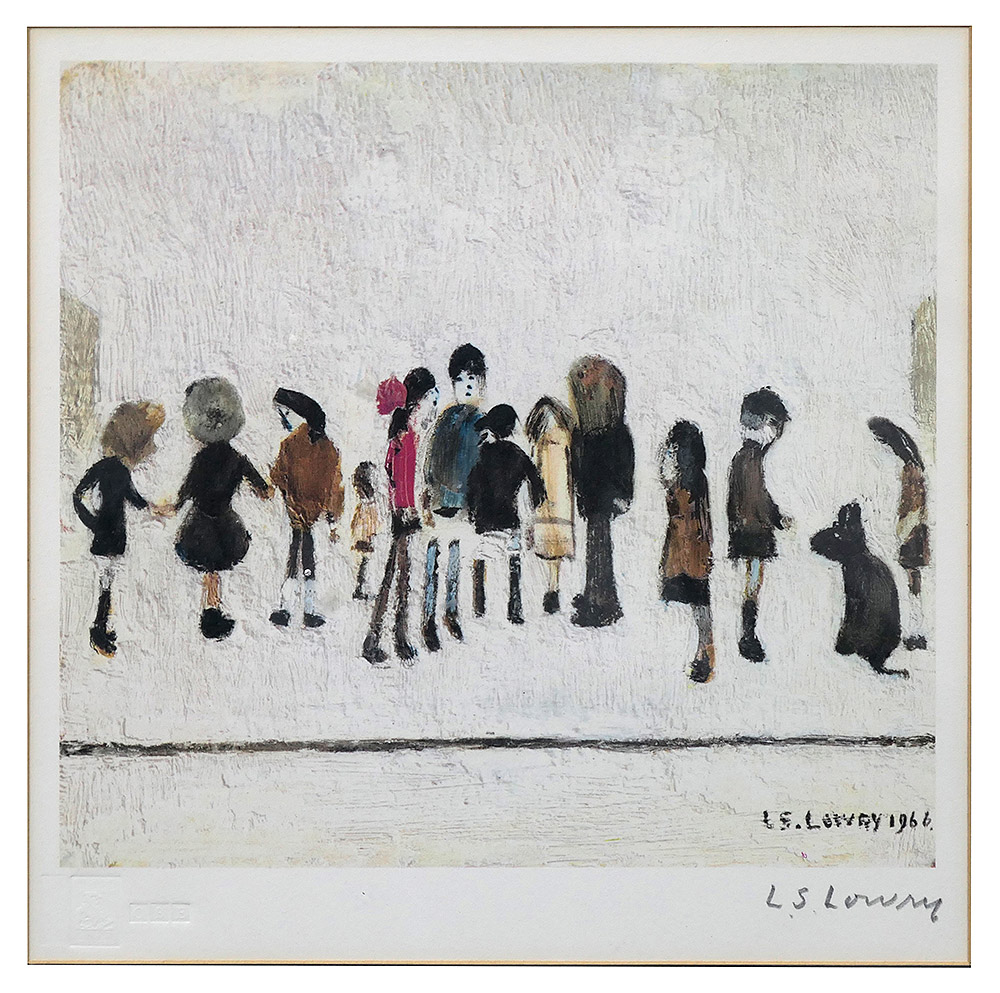L. S. Lowry
Laurence Stephen Lowry
23/10/2025 Blog
Few 20th-century British artists are as instantly recognisable and as beloved as Laurence Stephen Lowry. Born in Manchester in 1887, he is known for his distinctive depictions of industrial northern England, which capture places and people with affection and a deceptive simplicity.
Lowry grew up in the industrial districts of Pendlebury and Salford, places that would provide lifelong inspiration for his paintings. As a child, he was introspective and observant, showing an early interest in drawing. In adult life, Lowry worked as a rent collector by day, painting during evenings and weekends, which allowed him to minutely observe the daily rhythms of working-class life. He would sketch on whatever piece of paper he could get his hands on including napkins and envelopes, later creating more finished drawings. He also started painting, which he only ever did at home in his “studio” – which was very likely originally his dining room.

Lowry's formal education included studies at the Manchester School of Art, where he was taught by the French Impressionist Pierre Adolphe Valette. There, he developed a keen eye for the effects of light, which he used to dramatic effect in his brooding seascapes and haunting portraiture. However, he is probably best known for his naïve depictions of industrial Northwest England. Lowry's paintings are instantly recognisable with their bustling mill scenes, looming factory chimneys, and the famous, mostly expressionless, "matchstick men" and women that populate his work. Works such as "Coming from the Mill" (1930), "Going to the Match" (1953), and "Going to Work" (1943) are celebrated examples of his evocative portrayal of urban life. He often claimed only to use the colours flake white, ivory black, vermilion, Prussian blue, and ochre, which gave his scenes a muted atmosphere.
Yet, beyond their surface simplicity, Lowry's paintings possess great depth. His figures, though stylised and uniform, convey a sense of community and resilience amidst the harsh realities of industrial England. As the artist himself said in a Tyne Tees interview in 1968, "I've a one-track mind, Sir Poverty and gloom. Never a joyous picture of mine you'll see. Always gloom. I never do a jolly picture."

An artist recognised in his lifetime, Lowry exhibited regularly at the Royal Academy from the 1930’s onwards and was made an official war artist in 1943. In 1953, he was appointed an Official Artist at the coronation of Queen Elizabeth II.
By the 1960’s and 70’s, Lowry was well established, which is when he started to produce limited edition prints. Some were reproductions of his original paintings while others were produced expressly as print editions. These can be very sought after in auction and are often included in our quarterly Fine Art sales here at Sheffield Auction Gallery. These prints often feature an edition number marked in pencil ranging from 75 to 850 as well as a ‘blind stamp’, which is an image or design created by a depression in the paper. On signed editions this stamp is typically located on the left of the image, whilst for unsigned editions it will be in the centre of the image. Prices at auction vary greatly depending on the rarity of the print and the size of the edition produced. “Going to the Match” is the most sought-after Lowry signed print which can fetch up to £25,000 but other works usually sell for between £1,000-5,000.

Today, Lowry's paintings are held in major collections and public galleries, most notably The Lowry at Salford Quays. Tate Britain held a retrospective dedicated to Lowry in 2013 and features several pieces in its permanent collection.
Lowry's enduring appeal lies in his ability to capture the spirit of a place and its people. His paintings evoke a nostalgia for a bygone era while acknowledging the struggles and pleasures of ordinary life.
As always if you would like any assistance on buying or selling Lowry signed prints we are here to help you.